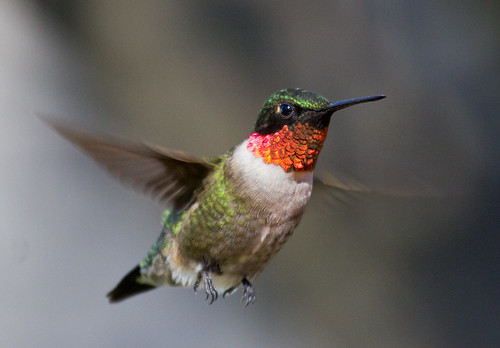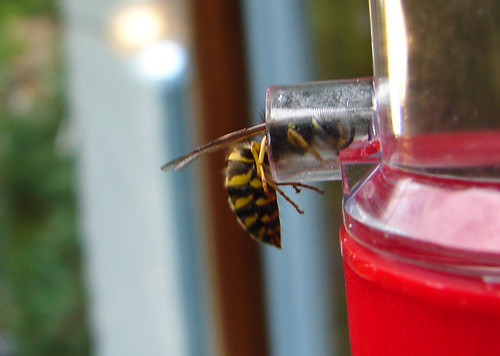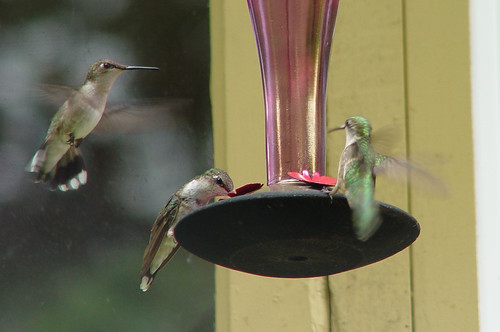
Mid- to late-August is the peak migration period for Ruby-throated Hummingbirds passing through the upper Midwest, and sure enough, my hummingbird feeders have been hopping for the past couple of weeks. I got to spend August 16 in Henderson, Minnesota, at their annual Henderson Hummingbird Hurrah, a birding festival specifically celebrating these tiniest of all breeding birds in the East. Participants get to watch Donald Mitchell banding hummingbirds. Very few bird banders are certified to trap and band hummingbirds—they need specialized training and special equipment—and Don is not just a valuable treasure at the hummingbird festival for his banding qualifications but also because he’s knowledgeable about a great many topics pertaining to hummingbirds and hummingbird gardening. (His webpage is specifically about hummingbird gardening.)
This year several people have asked me about the differences between cane and beet sugar, and I’ve heard a few people say that hummingbirds shun beet sugar, so I asked Donald Mitchell about that. He said he goes through so much sugar water, in his own backyard and wherever he’s setting up his traps, that he buys whatever is cheapest, which invariably is beet sugar. He says he’s never had a bit of trouble attracting and keeping hummingbirds with it. So when people are having difficulties attracting hummingbirds, the problems are almost certainly not related to the kind of sugar.
Other people asked Don about some other rules about hummingbird feeders. He emphasized that there is absolutely no reason to ever add food coloring to hummingbird feeders, and that it may well be harmful. Sheri Williamson, a hummingbird authority from Arizona, says there is plenty of science showing the dangers of red dye, based on studies on humans, lab animals, and even cell cultures. Sheri has a particular antipathy for commercial hummingbird food mixtures, which are really nothing but “overpriced, overpackaged sugar adulterated with unnatural, unnecessary, and potentially hazardous chemicals.”
There is no need to boil water or go to any trouble mixing sugar water. Tap water is just fine. Distilled water lacks minerals, and so some researchers caution against using it.
When you have lots of hummingbirds, feeders get emptied frequently. When you don’t, the sugar water should be changed every two or three days anyway—whether you boiled the water or not, and whether you used distilled water or not, the moment a hummingbird’s bill and tongue are inserted, germs are present, and little by little the water gets cloudy. Thoroughly rinsing the feeder, using a toothbrush or bottlebrush in any crevices, is a good idea, especially if you waited a bit too long to change the water.

Don said if you’re having trouble with wasps and bees, the best feeders are the bowl-type, because they can be filled just partway, making it too hard for insects to reach the sugar water while hummingbirds have no trouble.

The sweetness of natural flower nectar is all over the map, but in the flowers most well adapted to hummingbirds, the ratio of sucrose to water varies between about 1:5 and 1:3. The best concentration for feeders over the widest conditions is about a ¼ cup of sugar per cup of water, but you can make it stronger, up to about 1/3 cup of sugar per cup of water, which is especially valuable during cooler or wetter conditions. During droughts and excessively hot weather, making it a bit weaker, or about 1/5 cup of sugar per cup of water, can be healthier for birds in danger of dehydration. Of course, if that's hard to remember, 1/4 cup of sugar per cup of water is perfectly okay all the time.

For the next two weeks or so, hummingbird feeders are going to be buzzing with activity, but within another couple of weeks, hummingbirds will pretty much disappear from the northland. I’ll still keep my feeders going well into fall. Hummingbirds need a lot more than sugar water, and even the best feeding stations won’t keep them longer than the birds need for replenishing their fat to fuel their migration. I’ve had hummingbirds at least occasionally every October that I’ve left my feeders out, and the one time I maintained a feeder into November, a Rufous Hummingbird turned up. But right now is when feeders are almost guaranteed to attract hummingbirds, and that makes the end of August a perfect time of year.